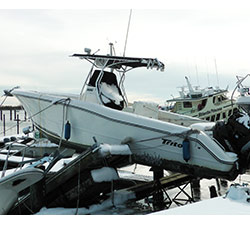USED BOAT BUYERS BEWARE: ARE YOU BUYING A HURRICANE SANDY BOAT?

With the fall boat buying season approaching, buyers looking for a pre-owned boat can often find deals as sellers, not wanting to take on the upcoming expense of winter storage fees, are in the bargaining mood. However, Boat Owners Association of The United States (BoatUS) estimates that 65,000 boats were damaged or lost when Superstorm Sandy struck. Now, nearly a year later, some of those boats are being sold on the used boat market, either in “as is” condition, or after repairs have been made. That’s not necessarily a bad thing if the seller is truthful about any past damage. However, the problem exists when sellers fail to fess up to a boat’s true condition. So how does a used boat buyer go into a purchase with eyes wide open?
The BoatUS Consumer Affairs Department has these used boat buying tips – each may be an indication the boat has experienced hurricane damage. Trace the history: When a car is totaled, the title is “branded” as salvaged or rebuilt and buyers know up front that there was major damage at some point in the car’s history. But few states brand salvaged boats and some states don’t even require titles for boats. “Anyone wishing to obscure a boat’s history need only cross state lines to avoid detection, which can be a tip-off,” says BoatUS Consumer Affairs Director Charles Fort. Also look for recent gaps in the boat’s ownership, which may mean that it was at an auction or in a repair yard for a long time.
Ask the seller: In some states, a seller is not required to disclose if a boat was badly damaged unless you ask them. If the seller hems and haws, keep looking. Look for evidence of storm damage. A boat you are looking at has an increased likelihood of having been badly damaged in a storm if you see two or three of the following:
Recent hull repair: Especially on older boats, matching gel-coat is very difficult. Mismatched colors around a repaired area are often a dead give away, and may signal nothing more than filler under the gel-coat, rather than a proper fiberglass repair.
New repairs or sealant at the hull-to-deck joint: Boats that bang against a dock or other boats during a storm often suffer damage here.
Evidence of sinking: Check for consistent corrosion on interior hardware, such as rust on all hinges and drawer pulls. You might be able to spot an interior waterline inside a locker or in an area hidden behind an internal structure.
Extensive corrosion in the electrical system: Corrosion on electrical items, such as lamps, connectors, and behind breaker panels might mean the boat sank recently. Does the boat have all brand new electronics? Why?
Evidence of major interior repairs: Fresh paint or gel-coat work on the inside of the hull and the engine room is usually obvious. All new cushions and curtains can be a tip-off too.
Again, having one or more of these indicators doesn’t always signal serious hurricane damage. The older the boat, the more likely some of these issues will pop up due to simple wear and tear. While something can be said about trusting your gut when seeing these red flags, make sure you have a professional inspect any used boat you’re considering. BoatUS offers a directory of surveyors at www.BoatUS.com/surveyors. Canadian surveyors can be located through www.marinesurvey.org – Search by Region – Society of Accredited Marine Surveyors AMS®
Wallace Gouk, (http://www.pcmarinesurveys.com) in Port Credit, Ontario commented, "Oh yeah…Sandy boats started arriving in Canada within two weeks of the storm. Buyers need an accredited and experienced marine surveyor for sure!"
Photo Caption: Boats damaged in Superstorm Sandy boats are being sold on the used boat market. The challenge for buyers is fully understanding any damage or repair issues, says BoatUS.
























